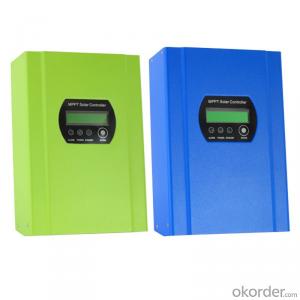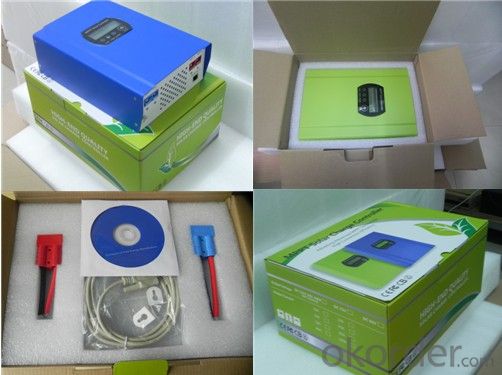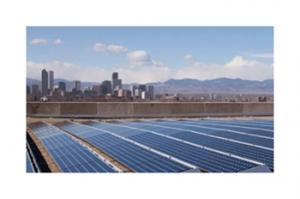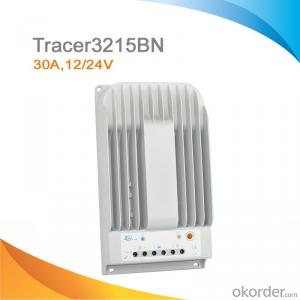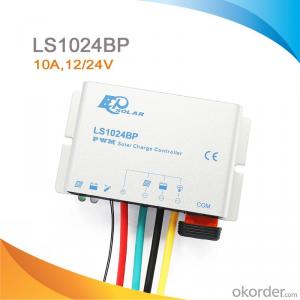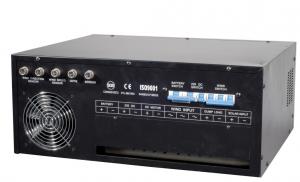Choosing Mppt Solar Controllers:Multifunctional 30A 12V 24V 48V Battery MPPT Solar Charge Controller 40A~60A
- Loading Port:
- China main port
- Payment Terms:
- TT OR LC
- Min Order Qty:
- 20 unit
- Supply Capability:
- 9999 unit/month
OKorder Service Pledge
OKorder Financial Service
You Might Also Like
solar power regulator controller,mppt charge controller 60A 12v/24v/48v mppt
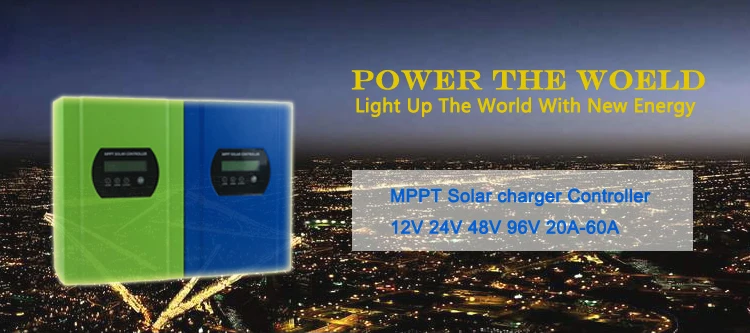
Hi, this is I-P- Smart1-DC12V/24V/48V-60A MPPT Solar Controller. With MPPT, it can target the highest output possibe from PV panels, make efficiency higher upto 30%~60% than traditional PWM ones. It can store energy to different kinds of batteries(Gel,Vented, Sealed,NiCd). More details please check the following information:
| Product Show |
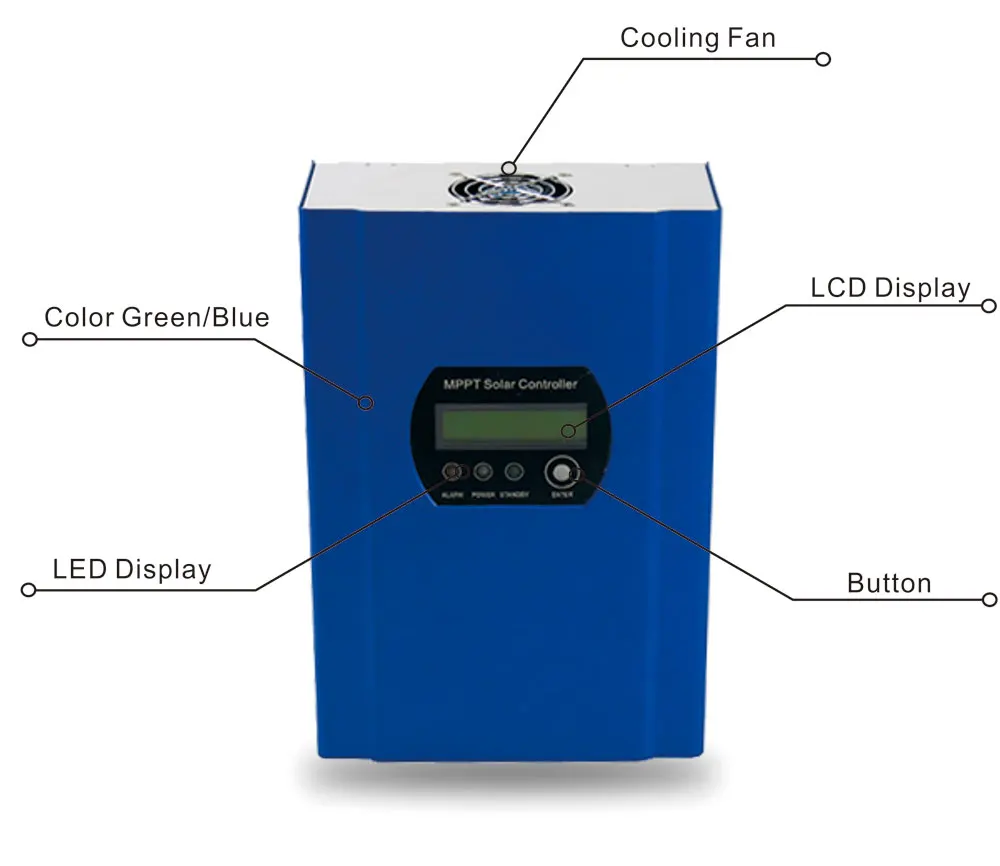
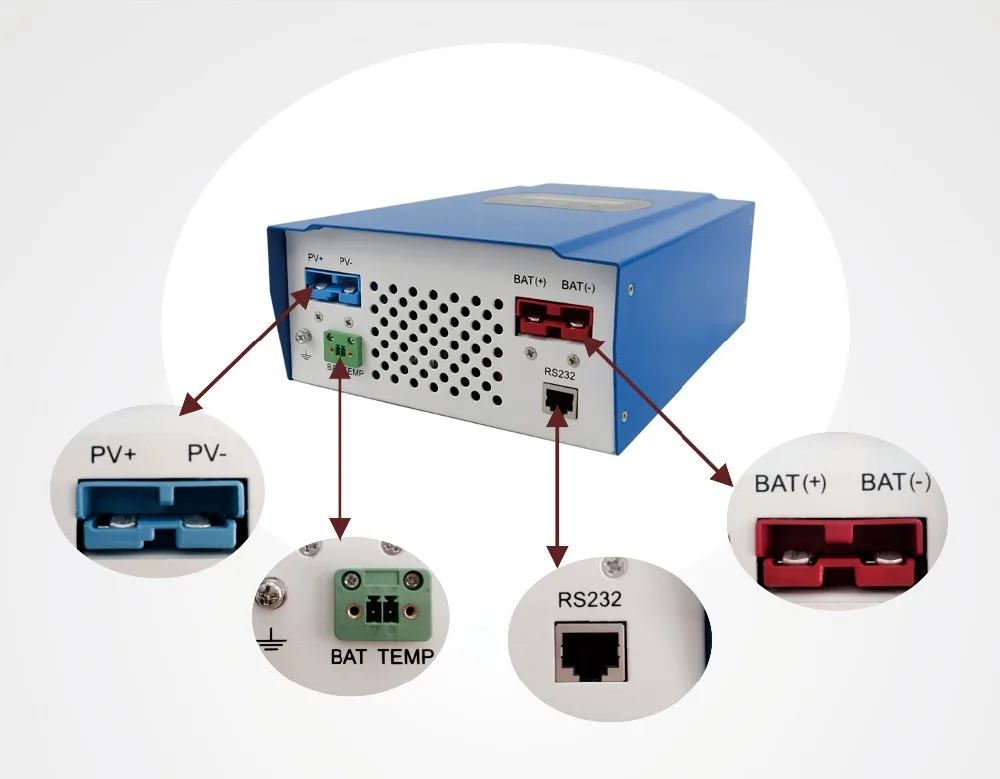
| Application |
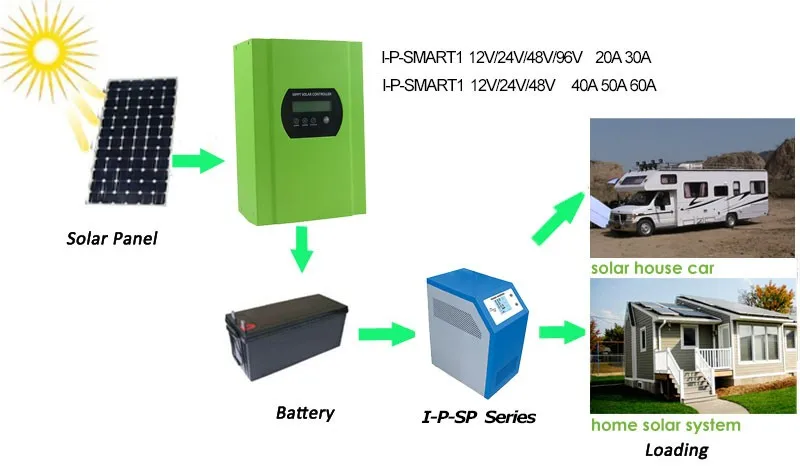
| Features |
1. Peak efficiency upto 99% with MPPT,increasing 30%~60% efficiency than traditional controller.
2. 12v/24v/48v system voltage automatic recognize.
3. Maximum input PV voltage upto DC150V.
4. 105degrees can be sufferred by good components.
5. Charge mode: three stages (fast charge, constant charge, floating charge)
6. Support kinds of batteries:Gel,Sealed lead acid,vented,NiCd,etc.
7. LCD and LED show parameters and system information,like PV input voltage,battery voltage,charge current,charge power,etc.
8. Port RS232 or connects to PC with upper software to show working state and parameters in 11 languages.
9. CE,RoHS certificatons approved.
10. 2 years warranty;3~10 years extended technical service.
RS232 Function working stat |
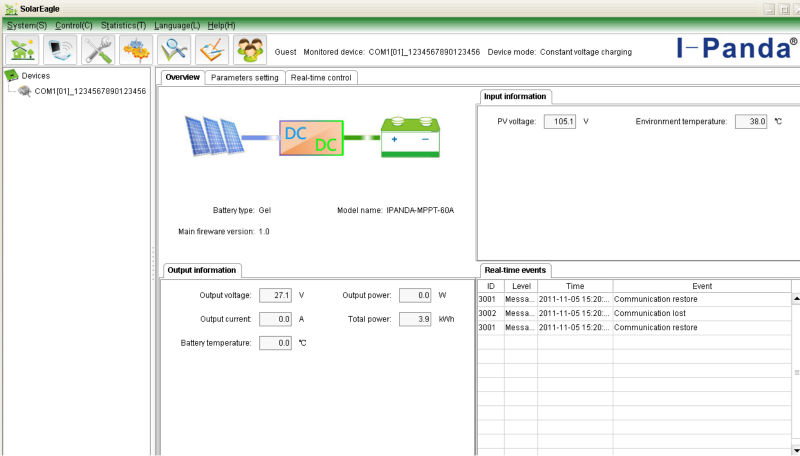
parameters |
Model:I-P-MSC-DC12V/24V/48V-series | 40A | 50A | 60A | ||||
Charge Mode | Maximum Power Point Tracking | ||||||
Method | 3 stages: fast charge(MPPT),constant voltage,floating charge | ||||||
System Type | DC12V/24V/48V | Automatic recognition | |||||
System Voltage | 12V system | DC9V~DC15V | |||||
24V system | DC18V~DC30V | ||||||
48Vsystem | DC36V~DC60V | ||||||
Soft Start Time | 12V/24V/48Vsystem | ≤10S | |||||
Dynamic Response Recovery Time | 12V/24V/48Vsystem | 500us | |||||
Conversion Efficiency | 12V/24V/48Vsystem | ≥96.5%,≤99% | |||||
PV Modules Utilization Rate | 12V/24V/48Vsystem | ≥99% | |||||
Input Characteristics | |||||||
MPPT Working Voltage and Range | 12V system | DC18V~DC150V | |||||
24V system | DC34~DC150V | ||||||
48V system | DC65~DC150V | ||||||
Low Voltage Input Protection Point | 12V system | DC16V | |||||
24V system | DC30V | ||||||
48V system | DC60V | ||||||
Low Voltage Input Recovery Point
| 12V system | DC22V | |||||
24V system | DC34V | ||||||
48V system | DC65V | ||||||
Max DC Voltage | 12V/24V/48V system | DC160V | |||||
Input Overvoltage Protection Point | 12V/24V/48V system | DC150V | |||||
Input Overvoltage Recovery Point | 12V/24V/48V system | DC145V | |||||
Max. PV Power | 12V system | 570W | 700W | 900W | |||
24V system | 1130W | 1400W | 1700W | ||||
48V system | 2270W | 2800W | 3400W | ||||
Output Characteristics | |||||||
Selectable Battery Types (Default type is GEL battery) | 12V/24V/48Vsystem | Sealed lead acid, vented, Gel, NiCd battery | |||||
Constant Voltage | 12V/24V/48V system | Please check the charge voltage according to the battery type form. | |||||
Floating Charge Voltage | 12V/24V/48V system | ||||||
Over Charge Protection Voltage | 12V system | 14.6V | |||||
24V system | 29.2V | ||||||
48V system | 58.4V | ||||||
Rated Output Current | 12V/24V/48V system | 40A | 50A | 60A | |||
Current-limiting Protection | 12V/24V/48V system | 44A | 55A | 66A | |||
Temperature Factor | 12V/24V/48V system | ±0.02%/℃ | |||||
Temperature Compensation | 12V/24V/48V system | 14.2V-(The highest temperature-25℃)*0.3 | |||||
Output Ripples(peak) | 12V/24V/48V system | 200mV | |||||
Output Voltage Stability Precision | 12V/24V/48V system | ≤±1.5% | |||||
Remark |
1. All the above parameters come from our former customers' requirements, if you have special need, we can adjust the parameter for you, such as DC voltage, charging current, etc.
2.Payment terms: 100% By T/T; 30% by T/T in advance, balance by T/T ; 100% Western Union;
3.Delivery Terms: EXWorks
4.Delivery Time: sample 1-2 working days after payment; big order depends on the quantity;
5.Providing OEM & ODM service;
Packaging & Shipping |
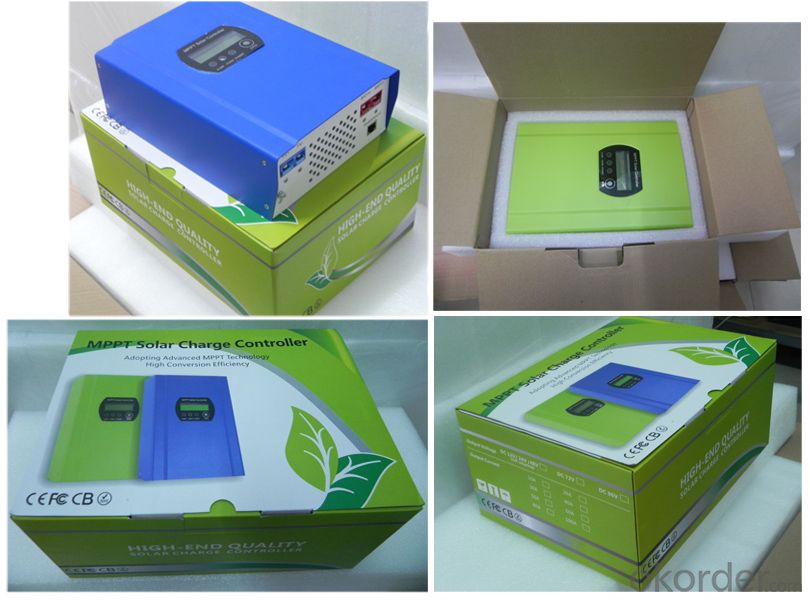
Certifications |
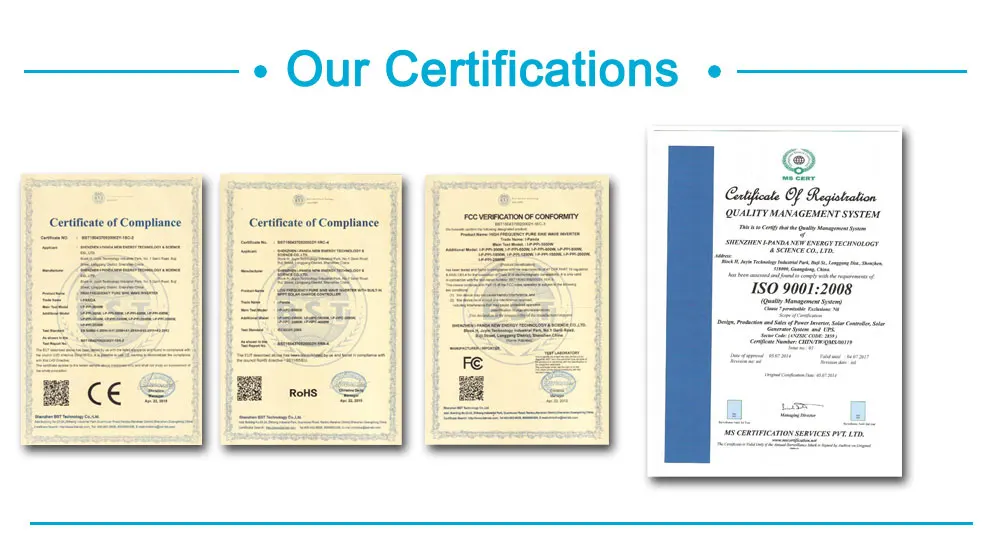
F&Q: |
Q1. How to ensure and monitor the products quality?
A1: We have established a perfect Quality Management System, In strict
accordance with ISO9001: 2008 quality system and ISO14001 environment system for quality assurance management;
Our ISO9001:2008 Quality System certificate encoding: CHIN/TW/QMS/00119;
Our ISO14001 Environment System certificate encoding: CHIN/TW/EMS/00028;
Q2. What is the warranty of products?
A2: The warranty period of different products are different; 5 years, 3 years, 2 years, 1 years; More details please refer to the product specification or manual; we will provide free life-long technical support ;
Q3. What is the difference between MPPT&PWM?
A3. MPPT charging mode, peak efficiency up to 99%, saving 30%~60% solar panel than traditional PWM controller.
- Q: Can a solar controller be used with solar-powered indoor waste management facilities?
- Yes, a solar controller can be used with solar-powered indoor waste management facilities. A solar controller is designed to regulate and optimize the charging and discharging of batteries in a solar power system. In an indoor waste management facility powered by solar energy, the solar controller can efficiently manage the charging of batteries using solar panels, ensuring a continuous and reliable power supply for waste management operations.
- Q: How do I connect a solar controller to my solar panels?
- To connect a solar controller to your solar panels, follow these steps: 1. Identify the positive and negative terminals on your solar panels. 2. Connect the positive wire from the solar panels to the positive terminal on the solar controller. 3. Connect the negative wire from the solar panels to the negative terminal on the solar controller. 4. Ensure that the connections are secure and tight. 5. Connect the battery terminals to the corresponding positive and negative terminals on the solar controller. 6. Finally, connect the load terminals on the solar controller to the device or system you wish to power using solar energy. Remember to consult the specific instructions provided by the manufacturer of your solar controller for accurate and safe installation.
- Q: Can a solar controller be used with a solar-powered agricultural research facility?
- Yes, a solar controller can be used with a solar-powered agricultural research facility. A solar controller helps regulate the flow of electricity from the solar panels to the battery storage system, ensuring optimal charging and preventing overcharging or discharging. It is essential for maintaining the efficiency and longevity of the solar power system in an agricultural research facility.
- Q: Are solar controllers necessary for small solar panel systems?
- Small solar panel systems require solar controllers. These controllers, also known as charge controllers or regulators, are vital components in any solar power system. They have the main responsibility of regulating and controlling the power that flows from the solar panels to the battery or grid. Solar controllers play a crucial role in protecting the battery from overcharging or discharging in small solar panel systems. They prevent the battery from being overcharged during sunny periods, which can harm and reduce its lifespan. Similarly, they also prevent excessive discharging during low sunlight or at night, which can cause damage as well. Additionally, solar controllers optimize the charging process by maximizing the efficiency of the solar panels. They employ techniques like pulse width modulation (PWM) or maximum power point tracking (MPPT) to ensure that the solar panels are always operating at their peak power output. This allows for the capturing of the maximum amount of energy from the sun and more effective battery charging. Furthermore, solar controllers often come with extra features such as temperature compensation, load control, and digital displays to provide information on the system's performance. These features are particularly beneficial for small solar panel systems where monitoring and control are important. In conclusion, although solar controllers may increase the cost of the system, the advantages they bring far outweigh the expense. They are indispensable components for small solar panel systems as they ensure efficient and safe operation, extend the battery's lifespan, and maximize the performance of the solar panels.
- Q: How do I connect a solar controller to a battery bank?
- To establish a connection between a solar controller and a battery bank, adhere to the subsequent guidelines: 1. Commence by situating the solar controller in close proximity to the battery bank, preferably within easy access to both the solar panels and the batteries. 2. Ascertain the positive and negative terminals on both the solar controller and the battery bank. Typically, the positive terminal is indicated by a "+" symbol or a red color, while the negative terminal is marked with a "-" symbol or a black color. 3. Employ a suitably sized cable or wire to link the positive terminal of the solar controller to the positive terminal of the battery bank. Guarantee that the connection is secure and firmly fastened. 4. Employ another appropriately sized cable or wire to connect the negative terminal of the solar controller to the negative terminal of the battery bank. Once again, ensure the connection is secure. 5. Thoroughly inspect all connections to verify the absence of loose or exposed wires that could potentially lead to a short circuit or other safety hazards. 6. Subsequent to confirming the security of all connections, activate the solar controller and adhere to the manufacturer's instructions to configure the settings, such as battery type and charging parameters, if necessary. 7. Regularly monitor the solar controller to ensure proper functionality and efficient charging of the battery bank. Adjust the settings as required to optimize the charging process. Always consult the manufacturer's instructions for your specific solar controller and battery bank to guarantee proper installation and operation. If uncertain about any step of the process, it is advisable to seek guidance from a professional or an experienced individual.
- Q: How does a solar controller protect the battery from overcharging?
- A solar controller protects the battery from overcharging by monitoring the voltage level of the battery and adjusting the charging current accordingly. When the battery reaches a certain voltage threshold, which indicates that it is fully charged, the solar controller reduces or completely cuts off the charging current to prevent overcharging. This process is also known as the "float" or "trickle" charging stage. By regulating the charging process, the solar controller ensures that the battery remains at a safe and optimal charging level, extending its lifespan and preventing damage caused by overcharging. Additionally, some advanced solar controllers may also incorporate features like temperature compensation and equalization charging to further protect the battery from overcharging and ensure its long-term performance.
- Q: Can a solar controller be used with a solar-powered university or college?
- Yes, a solar controller can be used with a solar-powered university or college. A solar controller is an essential component of a solar power system that regulates the voltage and current flow from the solar panels to the battery. It ensures the efficient and safe charging of the batteries, which are used to store the solar energy generated. Therefore, a solar controller is necessary to effectively manage and utilize the solar power in a university or college setting.
- Q: Can a solar controller be used with a solar-powered billboard or signage?
- Yes, a solar controller can be used with a solar-powered billboard or signage. A solar controller is used to regulate and optimize the charging and discharging of batteries in a solar power system. In the case of a solar-powered billboard or signage, the solar controller helps to manage the flow of electricity from the solar panels to the batteries, ensuring efficient and reliable power supply for the signage.
- Q: How does a solar controller handle reverse current flow from batteries to solar panels?
- A solar controller uses a built-in blocking diode to prevent reverse current flow from batteries to solar panels. The diode acts as a one-way valve, allowing current to flow from the solar panels to the batteries but blocking any current flow in the opposite direction. This ensures that the batteries do not discharge back into the solar panels during periods of low or no sunlight, protecting the system and optimizing its efficiency.
- Q: How does a solar controller prevent short circuits in the solar panel system?
- A solar controller prevents short circuits in the solar panel system by monitoring the voltage and current flowing through the system. It regulates the charging process and ensures that the solar panels do not exceed their maximum power output, thus preventing any excessive current flow that could potentially cause a short circuit. Additionally, the controller may have built-in protection mechanisms such as fuses or circuit breakers, which further safeguard the system against short circuits.
Send your message to us
Choosing Mppt Solar Controllers:Multifunctional 30A 12V 24V 48V Battery MPPT Solar Charge Controller 40A~60A
- Loading Port:
- China main port
- Payment Terms:
- TT OR LC
- Min Order Qty:
- 20 unit
- Supply Capability:
- 9999 unit/month
OKorder Service Pledge
OKorder Financial Service
Similar products
Hot products
Hot Searches
Related keywords
